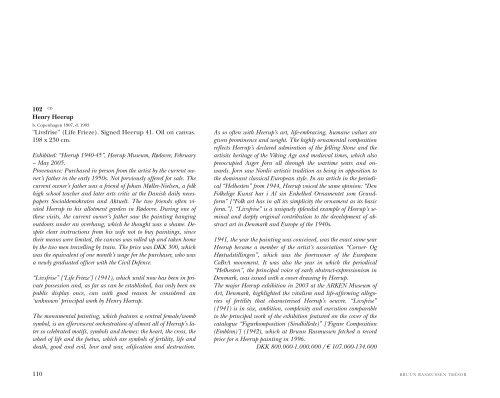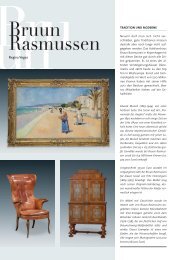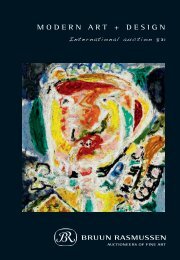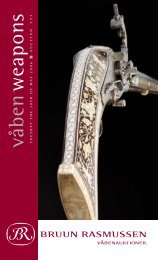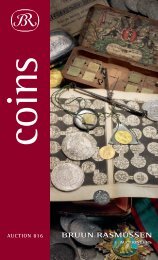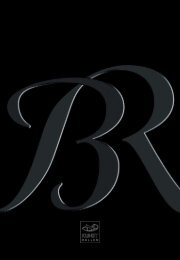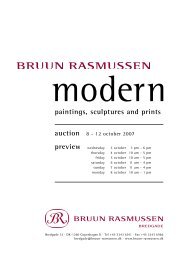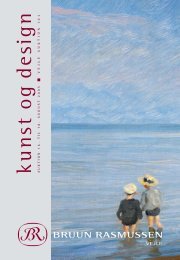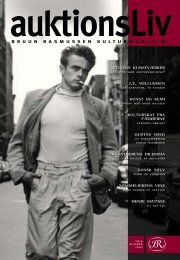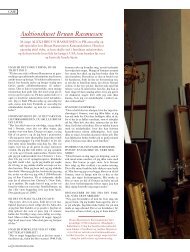Sell what you have plenty of Buy now - Bruun Rasmussen
Sell what you have plenty of Buy now - Bruun Rasmussen
Sell what you have plenty of Buy now - Bruun Rasmussen
You also want an ePaper? Increase the reach of your titles
YUMPU automatically turns print PDFs into web optimized ePapers that Google loves.
102 CD<br />
Henry Heerup<br />
b. Copenhagen 1907, d. 1993<br />
"Livsfrise" (Life Frieze). Signed Heerup 41. Oil on canvas.<br />
198 x 230 cm.<br />
Exhibited: “Heerup 1940-45”, Heerup Museum, Rødovre, February<br />
– May 2005.<br />
Provenance: Purchased in person from the artist by the current owner’s<br />
father in the early 1950s. Not previously <strong>of</strong>fered for sale. The<br />
current owner’s father was a friend <strong>of</strong> Johan Møller-Nielsen, a folk<br />
high school teacher and later arts critic at the Danish daily newspapers<br />
Socialdemokraten and Aktuelt. The two friends <strong>of</strong>ten visited<br />
Heerup in his allotment garden in Rødovre. During one <strong>of</strong><br />
these visits, the current owner’s father saw the painting hanging<br />
outdoors under an overhang, which he thought was a shame. Despite<br />
clear instructions from his wife not to buy paintings, since<br />
their means were limited, the canvas was rolled up and taken home<br />
by the two men travelling by train. The price was DKK 300, which<br />
was the equivalent <strong>of</strong> one month’s wage for the purchaser, who was<br />
a newly graduated <strong>of</strong>ficer with the Civil Defence.<br />
“Livsfrise” [‘Life Frieze’] (1941), which until <strong>now</strong> has been in private<br />
possession and, as far as can be established, has only been on<br />
public display once, can with good reason be considered an<br />
‘unk<strong>now</strong>n’ principal work by Henry Heerup.<br />
The monumental painting, which features a central female/womb<br />
symbol, is an effervescent orchestration <strong>of</strong> almost all <strong>of</strong> Heerup’s later<br />
so celebrated motifs, symbols and themes: the heart, the cross, the<br />
wheel <strong>of</strong> life and the foetus, which are symbols <strong>of</strong> fertility, life and<br />
death, good and evil, love and war, edification and destruction.<br />
As so <strong>of</strong>ten with Heerup’s art, life-embracing, humane values are<br />
given prominence and weight. The highly ornamental composition<br />
reflects Heerup’s declared admiration <strong>of</strong> the Jelling Stone and the<br />
artisitc heritage <strong>of</strong> the Viking Age and medieval times, which also<br />
preoccupied Asger Jorn all through the wartime years and onwards.<br />
Jorn saw Nordic artistic tradition as being in opposition to<br />
the dominant classical European style. In an article in the periodical<br />
“Helhesten” from 1944, Heerup voiced the same opinion: “Den<br />
Folkelige Kunst har i Al sin Enkelhed Ornamentet som Grundform”<br />
[“Folk art has in all its simplicity the ornament as its basic<br />
form.”]. “Livsfrise” is a uniquely splendid example <strong>of</strong> Heerup’s seminal<br />
and deeply original contribution to the development <strong>of</strong> abstract<br />
art in Denmark and Europe <strong>of</strong> the 1940s.<br />
1941, the year the painting was conceived, was the exact same year<br />
Heerup became a member <strong>of</strong> the artist’s association “Corner- Og<br />
Høstudstillingen”, which was the forerunner <strong>of</strong> the European<br />
CoBrA movement. It was also the year in which the periodical<br />
“Helhesten”, the principal voice <strong>of</strong> early abstract-expressionism in<br />
Denmark, was issued with a cover drawing by Heerup.<br />
The major Heerup exhibition in 2003 at the ARKEN Museum <strong>of</strong><br />
Art, Denmark, highlighted the vitalism and life-affirming allegories<br />
<strong>of</strong> fertility that characterised Heerup’s oeuvre. “Livsfrise”<br />
(1941) is in size, ambition, complexity and execution comparable<br />
to the principal work <strong>of</strong> the exhibition featured on the cover <strong>of</strong> the<br />
catalogue “Figurkomposition (Sindbillede)” [‘Figure Composition<br />
(Emblem)’] (1942), which at <strong>Bruun</strong> <strong>Rasmussen</strong> fetched a record<br />
price for a Heerup painting in 1996.<br />
DKK 800.000-1.000.000 / € 107.000-134.000<br />
110 BRUUN RASMUSSEN TRÉSOR


